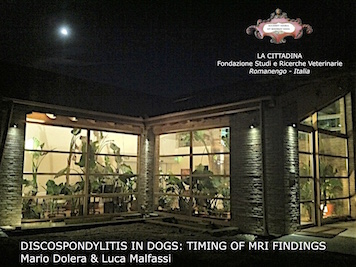CANINE DISCOSPONDYLITIS: TIMING OF MRI FINDINGS
Introduction/Purpose
The infections of the spine are inflammatory conditions of bacterial, fungal or parasitic etiology. The purpose of this work is to describe the MRI semeiology of discospondylitis in dogs with particular reference to the relationship between MRI findings and time of onset of the infection.
Materials and Methods
The inclusion criteria are the presence of discospondylitis and associated other inflammatory lesions (vertebral osteomyelitis, dorsal arthrosynovitis, paravertebral abscess or phlegmon, epidural abscess or phlegmon) diagnosed by MRI 1.5T and confirmed by bacteriology or histopathology or cytology. All patients underwent at least 1 MRI exam and, where possible and necessary to follow up, subsequent MRI examinations.
Results
89 dogs were considered. Type of pathology: discospondylitis only, 23%, discospondylitis and associated paravertebral phlegmon-abscess, 38%, discospondylitis and associated epidural phlegmon-abscess, 27%, discospondylitis and associated paravertebral and epidural phlegmon-abscess, 12%.
Localization: single 74%, multiple 26%, total of 64 discs involved. VERTEBRAL LESION Erosion. In the group of patients examined within 5 days from the onset, 18% show various degrees of end plates erosion. In the group between 6 and 10 days, 76% show erosions, present in 97% of animals over 10 days. Signal in 96% of discospondylitis, hyperintensity of the vertebrae involved is detected in seq TSE and STIR T2-weighted in all the time classes. In 98% of cases, there is enhancement in seq SE T1- weighted after intravenous contrast injection in all the time classes. DISCAL LESION Thickness. There is a reduction in thickness of the 100% of intervertebral discs involved by discospondylitis. Signal 78% of discs affected by discospondylitis are hyperintense on TSE and STIR T2-weighted, 90% are hypointense at baseline. After intravenous contrast medium injection, enhancement is present in 100% of involved discs. SPINAL CANAL LESIONS. 39% of patients show epidural phlegmon-abscess, 29% discal bulging, 23% thrombophlebitis, 9% meningitis. PARAVERTEBRAL LESIONS. 50% of patients with discospondylitis presents paravertebral phlegmon, 21% varying degrees of bony spurs and periosteal reaction.
Discussion/Conclusion
The MRI signs of discospondylitis more consistent and early detectable in all patients examined between 3 and 15 days are reduction of thickness of the disc involved, vertebral hyperintensity on TSE and STIR T2-weighted images, contrast enhancement of involved discs and vertebrae. On the basis of the data resulting from this study we can affirm the centrality of MRI in the diagnosis and therapeutic monitoring of spinal infections.
